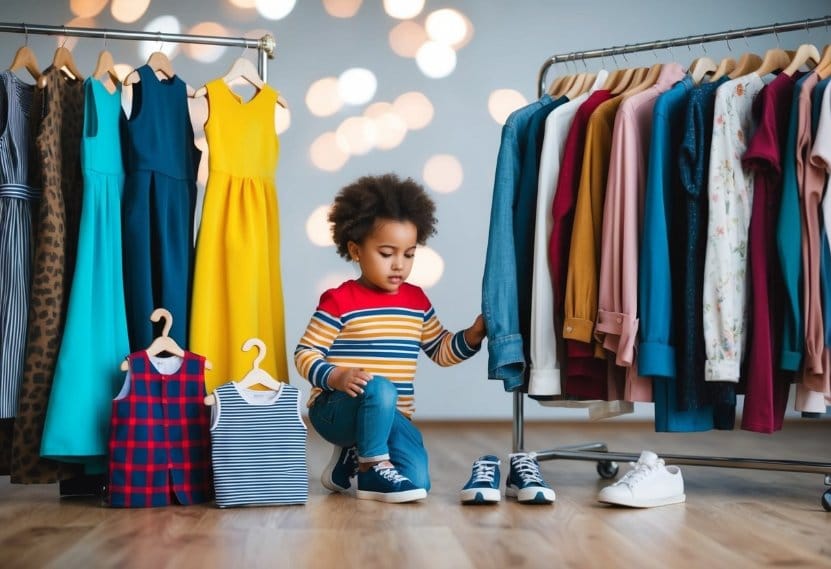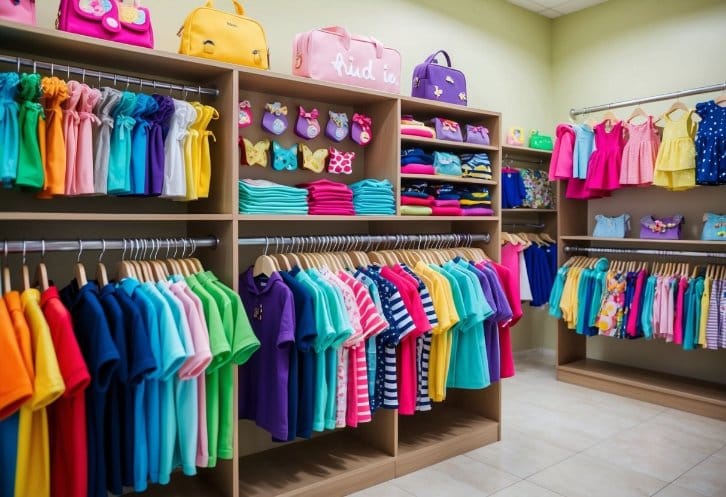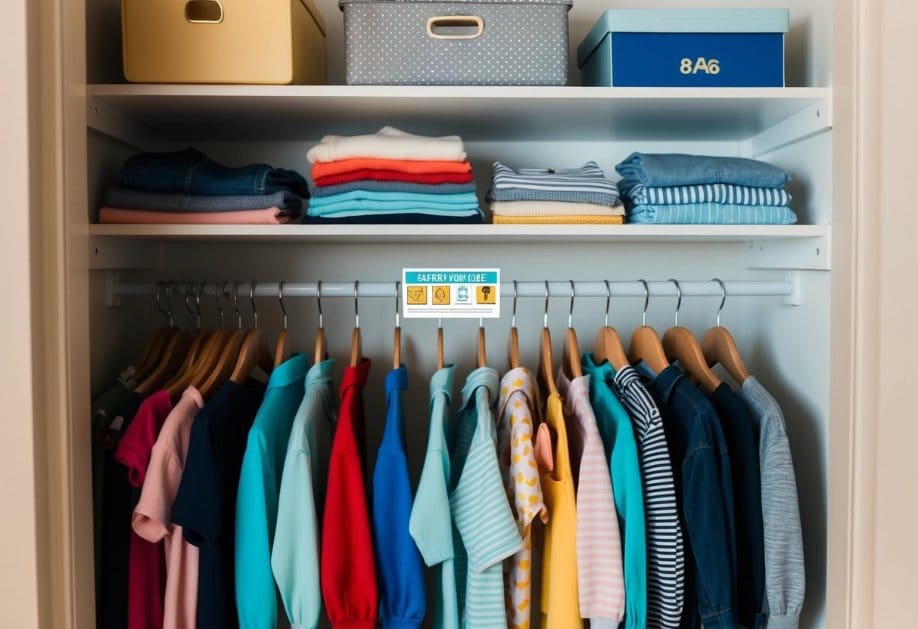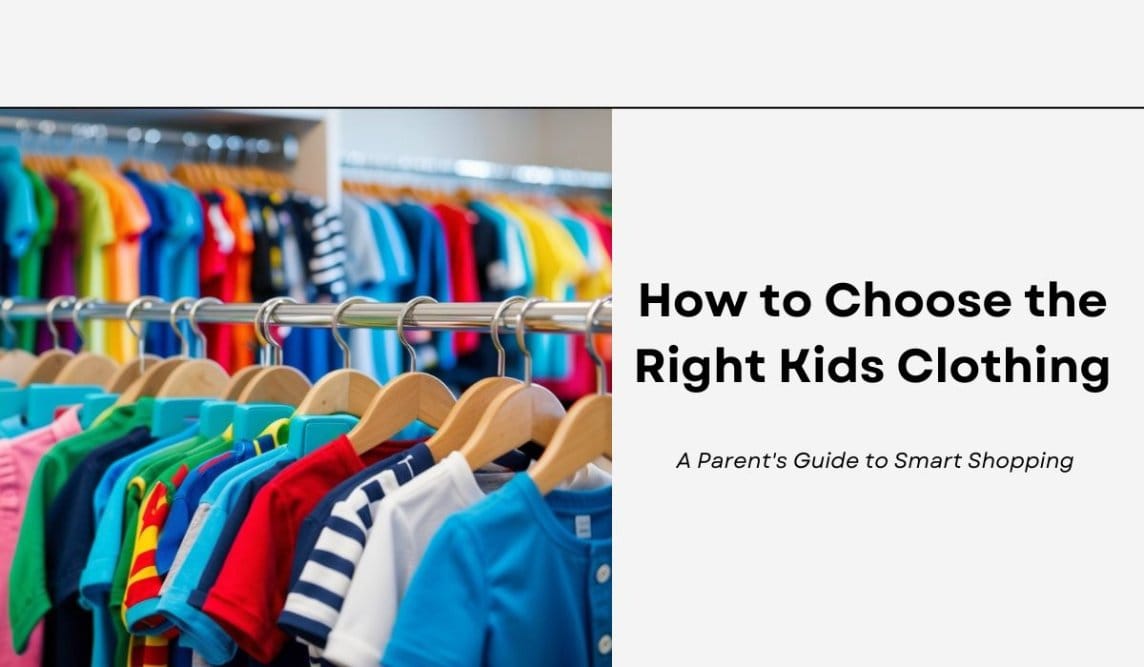From Size Charts to Seasonal Planning: Making Confident Decisions for Your Child’s Wardrobe
Choosing the right clothes for children can be a tricky task. Parents need to balance comfort, style, and practicality while ensuring their little ones look and feel great. Selecting clothing that is easy to put on and take off, with features like elastic waistbands and large buttons, is crucial for both infants and children learning to dress themselves.
When shopping for kids’ clothes, it’s essential to consider factors such as size, fabric, and functionality. Adjustable features like elastic waistbands and drawstrings can help ensure a proper fit as children grow. Additionally, parents should keep in mind the changing seasons and choose appropriate materials to keep their children comfortable year-round.
On This Page
Key Takeaways
- Select clothes with easy-to-manage fastenings and adjustable features for a better fit
- Choose fabrics and styles suitable for different seasons and activities
- Involve children in the selection process to ensure they feel comfortable and confident in their clothes
Understanding Kids’ Clothing Sizes
Choosing the right size for children’s clothing can be tricky. Kids grow quickly, and sizes can vary between brands. Let’s explore how to navigate sizing charts and account for growth spurts.
Sizing Chart Essentials
Sizing charts provide a clear breakdown of toddler and youth sizes. They typically include:
- Age ranges
- Height measurements
- Weight guidelines
To find the perfect fit, measure your child’s:
- Chest
- Waist
- Hip
- Inseam
Compare these measurements to the brand’s sizing chart. Remember, age ranges are just a guide. A 5-year-old might wear size 4 or 6 depending on their build.
Some brands use different sizing systems:
- Numeric (2, 3, 4, etc.)
- Letter (XS, S, M, L)
- “T” for toddler (2T, 3T, 4T)
Always check the specific brand’s chart for accuracy.
Adjusting for Growth Spurts
Kids can grow rapidly, making it challenging to buy clothes that fit for long. Here are some tips:
- Buy slightly larger sizes for longer wear
- Look for adjustable waistbands in trousers
- Choose stretchy fabrics for comfort during growth
Carters’ size chart includes recommendations for various clothing items. This can help you select sizes that allow room for growth.
Consider buying seasonal clothes at the start of the season in a size up. This ensures they’ll fit throughout the season.
For shoes, leave about a thumb’s width of space at the toe. This allows for growth without causing discomfort.
The Importance of Fabric Choice

Selecting the right fabric for children’s clothing is crucial for comfort and practicality. The material affects how well a garment performs in different weather conditions and activities.
Advantages of Breathable Fabrics
Breathable fabrics are essential for children’s clothing. They allow air to circulate, keeping kids cool and dry during play.
Cotton is a top choice for breathability. It’s soft, natural, and perfect for sensitive skin. Linen is another excellent option, especially for hot weather.
Bamboo fabric is gaining popularity. It’s not only breathable but also has moisture-wicking properties. This helps keep children comfortable even when they sweat.
Synthetic blends like cotton-polyester can offer breathability with added durability. These fabrics often dry quickly, making them ideal for active children.
Selecting All-Season Materials
All-season fabrics are versatile and cost-effective for children’s wardrobes. They work well in various temperatures and conditions.
Wool is a natural all-season material. It keeps kids warm in winter and cool in summer. Merino wool is particularly soft and suitable for children’s clothing.
Jersey knit is another great all-season choice. It’s stretchy, comfortable, and adapts well to different temperatures. This fabric is perfect for everyday wear.
Layering with different fabrics can create all-season outfits. A breathable base layer with adjustable outer layers allows for easy temperature regulation.
Consider fabric weight when choosing all-season materials. Medium-weight fabrics often perform best across different weather conditions.
Features for Functionality and Comfort

When choosing kids’ clothing, comfort and functionality are key. Smart design elements can make a big difference in how well garments work for active children.
Clothing with Adjustable Features
Adjustable features in kids’ clothing are brilliant for growing bodies. Elastic waistbands allow trousers to fit longer as children grow taller. Adjustable straps on dungarees and dresses let parents customise the fit.
Some jackets have extendable sleeves that unfold to cover growing arms. Shirts with roll-up sleeves secured by buttons offer versatility for different weather. These clever designs help clothes last longer, saving money for families.
Look for trainers with adjustable closures like Velcro or toggle laces. These make it easy for kids to put on their own shoes and adjust the fit as needed.
Evaluating Durability and Ease of Care
Durable kids’ clothes stand up to active play and frequent washing. Cotton blends often balance comfort with longevity. Reinforced knees on trousers prevent holes from forming quickly.
Check seams and buttons to ensure they’re securely attached. Double-stitched seams last longer than single-stitched ones. Look for clothes with strong zips that won’t break easily.
Easy-care fabrics save time for busy families. Choose machine-washable items that don’t require special handling. Stain-resistant treatments on school uniforms can be helpful. Quick-dry materials are great for swimwear and activewear.
Avoid clothes with fiddly embellishments that might fall off in the wash. Simple designs often hold up better over time.
Smart Shopping for Kids’ Wear

Finding quality children’s clothing at good prices takes some savvy strategies. There are many options to explore, from online shops to local thrift stores.
Navigating Online Shopping
Shopping for kids’ clothes online can be convenient and cost-effective. Start by comparing prices across different websites to find the best deals.
Look for sites with clear sizing guides and customer reviews. These help ensure a good fit and quality.
Many online shops offer sales and discounts throughout the year. Sign up for email newsletters to stay informed about these offers.
Consider buying multipacks or larger sizes that children can grow into. This approach often provides better value for money.
Exploring Thrift Stores and Consignment Shops
Local thrift stores and consignment shops can be treasure troves for kids’ clothing. These places often sell gently used items at a fraction of their original cost.
Visit shops regularly, as stock changes frequently. You might find designer labels or high-quality pieces at bargain prices.
Check clothes carefully for any damage or wear before purchasing. Most thrift stores don’t offer returns.
Some shops have specific sale days or loyalty programmes. Ask staff about these to maximise your savings.
Remember that clothes should be comfortable for children. Even if an item is cheap, it’s not a good buy if your child won’t wear it.
Seasonal Considerations in Children’s Clothing

Choosing the right clothes for kids as seasons change is crucial for comfort and practicality. Weather shifts impact what children should wear to stay cosy and protected.
Summer and Winter Wardrobe Essentials
For summer, lightweight and breathable fabrics are key. Cotton t-shirts, shorts, and sundresses help kids stay cool. Don’t forget sun hats and sunglasses for protection.
Swimwear is a must for beach trips or pool days. Pack a light jacket for chilly evenings.
Winter calls for warm layers. Thermal underwear forms a good base. Add jumpers, trousers, and thick socks. A waterproof coat is essential for rainy or snowy days.
Accessories like gloves, scarves, and hats keep little ones toasty. Waterproof boots are great for puddle-jumping and snow play.
Transitioning Between Seasons
Spring and autumn can be tricky. The weather often changes quickly. Layering is the best approach here.
Start with a t-shirt, add a light jumper, and top with a jacket. This way, kids can adjust their outfit as needed throughout the day.
Versatile pieces that work in both cooler and warmer weather are smart choices. Think long-sleeved tops, leggings, and lightweight jackets.
Buying seasonal clothes slightly too big can be a good strategy. This allows for growth, meaning items last longer.
Safety and Compliance in Clothing Selection

Choosing safe clothing for children is crucial. It involves understanding safety standards and being aware of potential chemical hazards in fabrics. These factors help parents make informed decisions when buying kids’ clothes.
Understanding Safety Standards
Safety standards for children’s clothing are designed to protect young ones from harm. They cover various aspects of garment design and construction.
Key safety features include:
- Secure attachment of buttons and decorations
- Absence of drawstrings in hood and neck areas
- Appropriate length of cords and ties
- Flame-resistant materials for sleepwear
Parents should check clothing labels for compliance with these standards. Look for certifications from recognised bodies that ensure the garment meets safety requirements.
It’s also important to consider age-appropriate clothing. What’s safe for older children may pose risks for infants or toddlers.
Chemicals and Allergens in Fabrics
Children’s skin is sensitive, making them more susceptible to irritants in fabrics. Toxic chemicals have been found in some children’s apparel, raising concerns about long-term health effects.
Common fabric chemicals to watch out for include:
- Formaldehyde
- Azo dyes
- Phthalates
- Lead
To minimise risk, opt for clothes made from natural, organic fibres. These are less likely to contain harmful chemicals. Wash new clothes before wear to remove any residual substances from manufacturing.
For children with sensitive skin or allergies, choose hypoallergenic fabrics. Cotton, bamboo, and certain synthetic blends can be good options. Always read care labels and follow washing instructions to maintain fabric integrity.
Involving Your Child in the Choice Process
Getting kids involved in choosing their clothes can be fun and beneficial. It helps them develop decision-making skills and express their personality.
Encouraging Self-Expression
Giving children choices in their clothing selection allows them to express themselves. Parents can start by offering two or three options that are appropriate for the occasion.
For younger children, this might mean picking between two shirts or deciding on a colour. Older kids can have more input in selecting entire outfits.
It’s important to set some boundaries. Parents should ensure the choices are weather-appropriate and suitable for the activity. This teaches children to make practical decisions while still feeling in control.
Shopping trips can be a great opportunity for kids to explore their style. Let them browse and point out items they like. This can lead to discussions about what makes clothing suitable or appealing.
Clothing and Confidence Building
The right clothes can boost a child’s confidence. When kids feel good in what they’re wearing, it shows in their behaviour and attitude.
Praising children for making good clothing choices reinforces their decision-making skills. It’s not just about looks, but also about choosing appropriate attire for different situations.
Parents can use clothing choices as a teaching tool. Discuss why certain clothes work better for specific activities or weather conditions. This helps children understand the practicality behind clothing decisions.
Encourage kids to take care of their clothes. Teaching them to fold, hang up, and look after their garments fosters responsibility and pride in their belongings.
Frequently Asked Questions
Selecting children’s clothing involves considering several key factors to ensure comfort, safety, and practicality. Parents often have common questions about choosing the right garments for their little ones.
What factors should be considered when selecting garments for children?
When choosing kids’ clothes, comfort is paramount. Fabric selection and fit are crucial factors to consider. Parents should opt for soft, breathable materials that don’t irritate the child’s skin.
Practicality is also important. Look for clothes that are easy to put on and take off, especially for younger children.
What guidelines can be followed to ascertain the correct size for children’s apparel?
Sizing can be tricky as children grow quickly. It’s best to measure the child regularly and compare these measurements to size charts provided by manufacturers.
Allow for some room to grow, but avoid buying clothes that are too large, as they can pose safety risks.
Which materials are recommended when purchasing attire for children?
Cotton is a popular choice for children’s clothing due to its softness and breathability. It’s gentle on sensitive skin and helps regulate body temperature.
For active wear, moisture-wicking fabrics like polyester blends can be suitable. They help keep children dry during physical activities.
How can one ensure the durability of children’s clothing?
To ensure durability, check the quality of stitching and fabric. Look for clothes that are easy to wash and care for.
Avoid delicate fabrics or those requiring special care, as they may not withstand the wear and tear of children’s daily activities.
What safety aspects must be kept in mind while choosing children’s wear?
Safety is crucial when selecting children’s clothing. Avoid items with small, detachable parts that could pose a choking hazard.
Ensure that drawstrings, if present, are short and securely fastened to prevent entanglement risks.
How does one balance comfort and style in children’s clothing selections?
Balancing comfort and style is achievable by choosing versatile pieces that are both functional and fashionable. Look for clothes in colours and designs that the child likes.
Opt for layered outfits that can be adjusted for comfort in different settings or weather conditions.
Related Post: How Often Should You Buy Kids’ Clothes?

